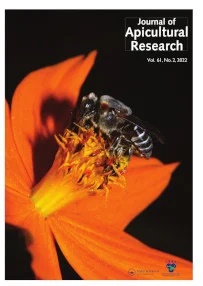Ver ítem
- xmlui.general.dspace_homeCentros e Institutos de InvestigaciónCICVyA. Centro de Investigación en Ciencias Veterinarias y AgronómicasInstituto de GenéticaArtículos científicosxmlui.ArtifactBrowser.ItemViewer.trail
- Inicio
- Centros e Institutos de Investigación
- CICVyA. Centro de Investigación en Ciencias Veterinarias y Agronómicas
- Instituto de Genética
- Artículos científicos
- Ver ítem
Bacterially expressed dsRNA induces Varroa destructor gene knockdown by honey bee-mediated oral administration
Resumen
The ectoparasite Varroa destructor causes serious losses of Apis mellifera colonies and negatively impacts the beekeeping industry around the world. New control methods have been proposed based on the RNA interference technique. Previous reports showed that parasitized honey bees fed with double-stranded RNA (dsRNA) synthesized in vitro reduce the transcription levels of target genes in Varroa mites. An efficient and inexpensive alternative to produce
[ver mas...]
The ectoparasite Varroa destructor causes serious losses of Apis mellifera colonies and negatively impacts the beekeeping industry around the world. New control methods have been proposed based on the RNA interference technique. Previous reports showed that parasitized honey bees fed with double-stranded RNA (dsRNA) synthesized in vitro reduce the transcription levels of target genes in Varroa mites. An efficient and inexpensive alternative to produce dsRNA is the use of bacteria capable of achieving high levels of in vivo synthesis. In the present study, dsRNA synthetized in vivo was used to induce gene silencing in V. destructor and evaluate their effect on the survival of both honey bees and the parasitic Varroa mites. The results evidenced that dsRNA fed to the bees engendered gene silencing in mites, inhibiting expression levels of target genes by 50%. Indeed, a reduction of 50% in Varroa survival was observed when bacterially expressed dsRNAs were administered to mite-parasitized bees. Worker bees that were fed with Varroa-targeted dsRNA by oral route showed no survival differences compared to control bees, fed with sucrose or dsRNA-GFP solutions. Our results demonstrated that specific dsRNA over-expressed in bacteria is capable of reducing mite survival by bee-mediated oral administration. This study provides an efficient and low-cost method for dsRNA production to control parasites and honey bee diseases.
[Cerrar]

Fuente
Journal of Apicultural Research (Published online: 01 Feb 2022)
Fecha
2022-02
Editorial
Taylor and Francis
ISSN
0021-8839
Documentos Relacionados
Formato
pdf
Tipo de documento
artículo
Proyectos
(ver más)
INTA/PNAPI-1112042/AR./Estrategias multidisciplinarias para mitigar el efecto del nuevo contexto ambiental y productivo sobre la colmena.
INTA/2019-PE-E1-I017-001/2019-PE-E1-I017-001/AR./DESARROLLO DEL SECTOR APÍCOLA ORGANIZADO, SUSTENTABLE Y COMPETITIVO
Palabras Claves
Derechos de acceso
Restringido
 Excepto donde se diga explicitamente, este item se publica bajo la siguiente descripción: Creative Commons Attribution-NonCommercial-ShareAlike 2.5 Unported (CC BY-NC-SA 2.5)
Excepto donde se diga explicitamente, este item se publica bajo la siguiente descripción: Creative Commons Attribution-NonCommercial-ShareAlike 2.5 Unported (CC BY-NC-SA 2.5)

